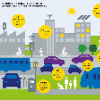A smart city can be seen as a framework, comprised of Information and Communication Technologies (ICT). An intelligent network of connected devices that collect data with their sensors and transmit them using cloud technologies in order to communicate with other assets in the ecosystem plays a pivotal role in this framework. Maximizing the quality of life of citizens, making better use of resources, cutting costs, and improving sustainability are the ultimate goals that a smart city is after. Hence, data collected from connected devices will continuously get thoroughly analyzed to gain better insights into the services that are being offered across the city; with this goal in mind that they can be used to make the whole system more efficient. Robots and physical machines are inseparable parts of a smart city. Embodied AI is the field of study that takes a deeper look into these and explores how they can fit into real-world environments. It focuses on learning through interaction with the surrounding environment, as opposed to Internet AI which tries to learn from static datasets. Embodied AI aims to train an agent that can See (Computer Vision), Talk (NLP), Navigate and Interact with its environment (Reinforcement Learning), and Reason (General Intelligence), all at the same time. Autonomous driving cars and personal companions are some of the examples that benefit from Embodied AI nowadays. In this paper, we attempt to do a concise review of this field. We will go through its definitions, its characteristics, and its current achievements along with different algorithms, approaches, and solutions that are being used in different components of it (e.g. Vision, NLP, RL). We will then explore all the available simulators and 3D interactable databases that will make the research in this area feasible. Finally, we will address its challenges and identify its potentials for future research.
翻译:智能城市可以被视为由信息和通信技术(ICT)组成的一个框架。一个智能城市。一个智能的连接装置网络,用传感器收集数据,并用云层技术传输它们,以便与生态系统中的其他资产进行交流,在这个框架中发挥着关键作用。最大限度地提高公民生活质量,更好地利用资源,降低成本,提高可持续性,这是智能城市追求的最终目标。因此,从连接装置中收集的数据将不断得到彻底分析,以更好地了解整个城市正在提供的服务;这个目标铭记着它们可以用来提高整个系统的效率。机器人和物理机器是智能城市不可分割的一部分。Embodi AI是一个研究领域,更深入地研究这些特征,探索他们如何适应现实世界环境。它侧重于通过与周围环境的互动学习,而不是试图从静态数据集中学习的互联网AI。Embodied AI旨在培训一个可以理解(Computer Vision), Talk (NLP), 然后用它们可以用来提高整个系统的效率。Nabigate and Interact及其环境组成部分(Regrammentment)是智能城市的不可分割的部分部分。Erial Instal ex real redustrual redustration, ex to the ex, ex be the ex ex, ex the we ben ex.



